+ Open data
Open data
- Basic information
Basic information
| Entry | Database: PDB / ID: 6xkl | ||||||||||||
|---|---|---|---|---|---|---|---|---|---|---|---|---|---|
| Title | SARS-CoV-2 HexaPro S One RBD up | ||||||||||||
 Components Components | Spike glycoprotein | ||||||||||||
 Keywords Keywords | VIRAL PROTEIN / SARS-CoV-2 / glycoprotein / fusion protein | ||||||||||||
| Function / homology |  Function and homology information Function and homology informationsymbiont-mediated disruption of host tissue / Maturation of spike protein / Translation of Structural Proteins / Virion Assembly and Release / host cell surface / host extracellular space / viral translation / symbiont-mediated-mediated suppression of host tetherin activity / Induction of Cell-Cell Fusion / structural constituent of virion ...symbiont-mediated disruption of host tissue / Maturation of spike protein / Translation of Structural Proteins / Virion Assembly and Release / host cell surface / host extracellular space / viral translation / symbiont-mediated-mediated suppression of host tetherin activity / Induction of Cell-Cell Fusion / structural constituent of virion / entry receptor-mediated virion attachment to host cell / membrane fusion / Attachment and Entry / host cell endoplasmic reticulum-Golgi intermediate compartment membrane / positive regulation of viral entry into host cell / receptor-mediated virion attachment to host cell / host cell surface receptor binding / symbiont-mediated suppression of host innate immune response / receptor ligand activity / endocytosis involved in viral entry into host cell / fusion of virus membrane with host plasma membrane / fusion of virus membrane with host endosome membrane / viral envelope / symbiont entry into host cell / virion attachment to host cell / SARS-CoV-2 activates/modulates innate and adaptive immune responses / host cell plasma membrane / virion membrane / identical protein binding / membrane / plasma membrane Similarity search - Function | ||||||||||||
| Biological species |  | ||||||||||||
| Method | ELECTRON MICROSCOPY / single particle reconstruction / cryo EM / Resolution: 3.21 Å | ||||||||||||
 Authors Authors | Wrapp, D. / Hsieh, C.-L. / Goldsmith, J.A. / McLellan, J.S. | ||||||||||||
| Funding support |  United States, 1items United States, 1items
| ||||||||||||
 Citation Citation |  Journal: Science / Year: 2020 Journal: Science / Year: 2020Title: Structure-based design of prefusion-stabilized SARS-CoV-2 spikes. Authors: Ching-Lin Hsieh / Jory A Goldsmith / Jeffrey M Schaub / Andrea M DiVenere / Hung-Che Kuo / Kamyab Javanmardi / Kevin C Le / Daniel Wrapp / Alison G Lee / Yutong Liu / Chia-Wei Chou / Patrick ...Authors: Ching-Lin Hsieh / Jory A Goldsmith / Jeffrey M Schaub / Andrea M DiVenere / Hung-Che Kuo / Kamyab Javanmardi / Kevin C Le / Daniel Wrapp / Alison G Lee / Yutong Liu / Chia-Wei Chou / Patrick O Byrne / Christy K Hjorth / Nicole V Johnson / John Ludes-Meyers / Annalee W Nguyen / Juyeon Park / Nianshuang Wang / Dzifa Amengor / Jason J Lavinder / Gregory C Ippolito / Jennifer A Maynard / Ilya J Finkelstein / Jason S McLellan /  Abstract: The coronavirus disease 2019 (COVID-19) pandemic has led to accelerated efforts to develop therapeutics and vaccines. A key target of these efforts is the spike (S) protein, which is metastable and ...The coronavirus disease 2019 (COVID-19) pandemic has led to accelerated efforts to develop therapeutics and vaccines. A key target of these efforts is the spike (S) protein, which is metastable and difficult to produce recombinantly. We characterized 100 structure-guided spike designs and identified 26 individual substitutions that increased protein yields and stability. Testing combinations of beneficial substitutions resulted in the identification of HexaPro, a variant with six beneficial proline substitutions exhibiting higher expression than its parental construct (by a factor of 10) as well as the ability to withstand heat stress, storage at room temperature, and three freeze-thaw cycles. A cryo-electron microscopy structure of HexaPro at a resolution of 3.2 angstroms confirmed that it retains the prefusion spike conformation. High-yield production of a stabilized prefusion spike protein will accelerate the development of vaccines and serological diagnostics for severe acute respiratory syndrome coronavirus 2 (SARS-CoV-2). #1: Journal: bioRxiv / Year: 2020 Title: Structure-based Design of Prefusion-stabilized SARS-CoV-2 Spikes. Authors: Ching-Lin Hsieh / Jory A Goldsmith / Jeffrey M Schaub / Andrea M DiVenere / Hung-Che Kuo / Kamyab Javanmardi / Kevin C Le / Daniel Wrapp / Alison Gene-Wei Lee / Yutong Liu / Chia-Wei Chou / ...Authors: Ching-Lin Hsieh / Jory A Goldsmith / Jeffrey M Schaub / Andrea M DiVenere / Hung-Che Kuo / Kamyab Javanmardi / Kevin C Le / Daniel Wrapp / Alison Gene-Wei Lee / Yutong Liu / Chia-Wei Chou / Patrick O Byrne / Christy K Hjorth / Nicole V Johnson / John Ludes-Meyers / Annalee W Nguyen / Juyeon Park / Nianshuang Wang / Dzifa Amengor / Jennifer A Maynard / Ilya J Finkelstein / Jason S McLellan /  Abstract: The COVID-19 pandemic caused by the novel coronavirus SARS-CoV-2 has led to accelerated efforts to develop therapeutics, diagnostics, and vaccines to mitigate this public health emergency. A key ...The COVID-19 pandemic caused by the novel coronavirus SARS-CoV-2 has led to accelerated efforts to develop therapeutics, diagnostics, and vaccines to mitigate this public health emergency. A key target of these efforts is the spike (S) protein, a large trimeric class I fusion protein that is metastable and difficult to produce recombinantly in large quantities. Here, we designed and expressed over 100 structure-guided spike variants based upon a previously determined cryo-EM structure of the prefusion SARS-CoV-2 spike. Biochemical, biophysical and structural characterization of these variants identified numerous individual substitutions that increased protein yields and stability. The best variant, HexaPro, has six beneficial proline substitutions leading to ~10-fold higher expression than its parental construct and is able to withstand heat stress, storage at room temperature, and multiple freeze-thaws. A 3.2 Å-resolution cryo-EM structure of HexaPro confirmed that it retains the prefusion spike conformation. High-yield production of a stabilized prefusion spike protein will accelerate the development of vaccines and serological diagnostics for SARS-CoV-2. #2: Journal: bioRxiv / Year: 2020 Title: Structure-based Design of Prefusion-stabilized SARS-CoV-2 Spikes. Authors: Ching-Lin Hsieh / Jory A Goldsmith / Jeffrey M Schaub / Andrea M DiVenere / Hung-Che Kuo / Kamyab Javanmardi / Kevin C Le / Daniel Wrapp / Alison Gene-Wei Lee / Yutong Liu / Chia-Wei Chou / ...Authors: Ching-Lin Hsieh / Jory A Goldsmith / Jeffrey M Schaub / Andrea M DiVenere / Hung-Che Kuo / Kamyab Javanmardi / Kevin C Le / Daniel Wrapp / Alison Gene-Wei Lee / Yutong Liu / Chia-Wei Chou / Patrick O Byrne / Christy K Hjorth / Nicole V Johnson / John Ludes-Meyers / Annalee W Nguyen / Juyeon Park / Nianshuang Wang / Dzifa Amengor / Jennifer A Maynard / Ilya J Finkelstein / Jason S McLellan /  Abstract: The COVID-19 pandemic caused by the novel coronavirus SARS-CoV-2 has led to accelerated efforts to develop therapeutics, diagnostics, and vaccines to mitigate this public health emergency. A key ...The COVID-19 pandemic caused by the novel coronavirus SARS-CoV-2 has led to accelerated efforts to develop therapeutics, diagnostics, and vaccines to mitigate this public health emergency. A key target of these efforts is the spike (S) protein, a large trimeric class I fusion protein that is metastable and difficult to produce recombinantly in large quantities. Here, we designed and expressed over 100 structure-guided spike variants based upon a previously determined cryo-EM structure of the prefusion SARS-CoV-2 spike. Biochemical, biophysical and structural characterization of these variants identified numerous individual substitutions that increased protein yields and stability. The best variant, HexaPro, has six beneficial proline substitutions leading to ~10-fold higher expression than its parental construct and is able to withstand heat stress, storage at room temperature, and multiple freeze-thaws. A 3.2 Å-resolution cryo-EM structure of HexaPro confirmed that it retains the prefusion spike conformation. High-yield production of a stabilized prefusion spike protein will accelerate the development of vaccines and serological diagnostics for SARS-CoV-2. | ||||||||||||
| History |
|
- Structure visualization
Structure visualization
| Movie |
 Movie viewer Movie viewer |
|---|---|
| Structure viewer | Molecule:  Molmil Molmil Jmol/JSmol Jmol/JSmol |
- Downloads & links
Downloads & links
- Download
Download
| PDBx/mmCIF format |  6xkl.cif.gz 6xkl.cif.gz | 532.8 KB | Display |  PDBx/mmCIF format PDBx/mmCIF format |
|---|---|---|---|---|
| PDB format |  pdb6xkl.ent.gz pdb6xkl.ent.gz | 424.7 KB | Display |  PDB format PDB format |
| PDBx/mmJSON format |  6xkl.json.gz 6xkl.json.gz | Tree view |  PDBx/mmJSON format PDBx/mmJSON format | |
| Others |  Other downloads Other downloads |
-Validation report
| Summary document |  6xkl_validation.pdf.gz 6xkl_validation.pdf.gz | 2.1 MB | Display |  wwPDB validaton report wwPDB validaton report |
|---|---|---|---|---|
| Full document |  6xkl_full_validation.pdf.gz 6xkl_full_validation.pdf.gz | 2.2 MB | Display | |
| Data in XML |  6xkl_validation.xml.gz 6xkl_validation.xml.gz | 96.2 KB | Display | |
| Data in CIF |  6xkl_validation.cif.gz 6xkl_validation.cif.gz | 144 KB | Display | |
| Arichive directory |  https://data.pdbj.org/pub/pdb/validation_reports/xk/6xkl https://data.pdbj.org/pub/pdb/validation_reports/xk/6xkl ftp://data.pdbj.org/pub/pdb/validation_reports/xk/6xkl ftp://data.pdbj.org/pub/pdb/validation_reports/xk/6xkl | HTTPS FTP |
-Related structure data
| Related structure data |  22221MC M: map data used to model this data C: citing same article ( |
|---|---|
| Similar structure data |
- Links
Links
- Assembly
Assembly
| Deposited unit | 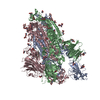
|
|---|---|
| 1 |
|
- Components
Components
| #1: Protein | Mass: 142427.438 Da / Num. of mol.: 3 / Mutation: F817P, A892P, A899P, A942P, K986P, V987P Source method: isolated from a genetically manipulated source Source: (gene. exp.)  Gene: S, 2 / Production host:  Homo sapiens (human) / References: UniProt: P0DTC2 Homo sapiens (human) / References: UniProt: P0DTC2#2: Polysaccharide | 2-acetamido-2-deoxy-beta-D-glucopyranose-(1-4)-2-acetamido-2-deoxy-beta-D-glucopyranose Source method: isolated from a genetically manipulated source #3: Sugar | ChemComp-NAG / Has ligand of interest | N | Has protein modification | Y | |
|---|
-Experimental details
-Experiment
| Experiment | Method: ELECTRON MICROSCOPY |
|---|---|
| EM experiment | Aggregation state: PARTICLE / 3D reconstruction method: single particle reconstruction |
- Sample preparation
Sample preparation
| Component | Name: Prefusion-stabilized SARS-CoV-2 spike trimer with a single RBD up Type: COMPLEX / Entity ID: #1 / Source: RECOMBINANT | ||||||||||||||||||||
|---|---|---|---|---|---|---|---|---|---|---|---|---|---|---|---|---|---|---|---|---|---|
| Molecular weight | Value: 0.6 MDa / Experimental value: YES | ||||||||||||||||||||
| Source (natural) | Organism:  | ||||||||||||||||||||
| Source (recombinant) | Organism:  Homo sapiens (human) Homo sapiens (human) | ||||||||||||||||||||
| Buffer solution | pH: 8 | ||||||||||||||||||||
| Buffer component |
| ||||||||||||||||||||
| Specimen | Conc.: 0.35 mg/ml / Embedding applied: NO / Shadowing applied: NO / Staining applied: NO / Vitrification applied: YES | ||||||||||||||||||||
| Specimen support | Grid material: COPPER / Grid mesh size: 400 divisions/in. / Grid type: C-flat-1.2/1.3 | ||||||||||||||||||||
| Vitrification | Instrument: FEI VITROBOT MARK IV / Cryogen name: ETHANE / Humidity: 100 % / Chamber temperature: 277.15 K |
- Electron microscopy imaging
Electron microscopy imaging
| Experimental equipment |  Model: Titan Krios / Image courtesy: FEI Company |
|---|---|
| Microscopy | Model: FEI TITAN KRIOS |
| Electron gun | Electron source:  FIELD EMISSION GUN / Accelerating voltage: 300 kV / Illumination mode: FLOOD BEAM FIELD EMISSION GUN / Accelerating voltage: 300 kV / Illumination mode: FLOOD BEAM |
| Electron lens | Mode: BRIGHT FIELD |
| Image recording | Electron dose: 45 e/Å2 / Film or detector model: GATAN K3 (6k x 4k) |
- Processing
Processing
| EM software |
| ||||||||||||||||||
|---|---|---|---|---|---|---|---|---|---|---|---|---|---|---|---|---|---|---|---|
| CTF correction | Type: PHASE FLIPPING AND AMPLITUDE CORRECTION | ||||||||||||||||||
| Particle selection | Num. of particles selected: 695490 | ||||||||||||||||||
| Symmetry | Point symmetry: C1 (asymmetric) | ||||||||||||||||||
| 3D reconstruction | Resolution: 3.21 Å / Resolution method: FSC 0.143 CUT-OFF / Num. of particles: 85675 / Details: Non-uniform refinement / Symmetry type: POINT |
 Movie
Movie Controller
Controller






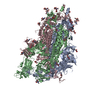


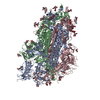


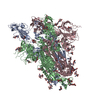

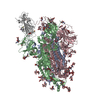

 PDBj
PDBj





